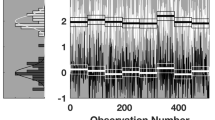Abstract
There is, at present, no single theory around which systems thinkers of the hard and soft schools might reasonably unite. Viewpoints and methods they invoke tend, even today, to be either hard or soft. There are many potential advantages of a single theory, particularly where systems consist of quite varied parts, such as sociotechnical systems. The advent particularly of chaos and catastrophe concepts gives cause to reflect that prescriptive viewpoints and methods must have limits in changing environments. The unified systems hypothesis uses configuration entropy as itslingua franca or unifying concept, because systems are either tangible or perceived reductions in disorder, by the nature of the way we think and define them. It seeks understanding by examining complex systems of all types: physical, chemical, biological, social human and nonhuman, ecological, stellar, etc. It avoids pejorative viewpoints about “right” and “wrong” or “control.” Seven principles are developed: the principles of systems reactions, system cohesion, system adaptation, connected variety, limited variety, preferred patterns, and cyclic progression. Together, these principles form a “map” on to which the life cycle, not of a single system, but of a set of open, interacting systems, can be mapped. The principles indicate the reasons for set members to come together, the emergence of chaotic, catastrophic, linear, or dominated interactions within the set, the basis for stability of the set, the causes of decay and collapse, and the recycling of the components. The principles are also presented in finite-state/transition form. USH is the sum of the principles, rather than any on its own, and describes systems life-cycle phases and the reasons for transition between them. USH is used to explore briefly a wide variety of economic, political, business, and organizational and engineering systems.
Similar content being viewed by others
References
Arthur, B. W. (1990). Positive feedbacks in the economy.Sci. Am. 262(2).
Ashby, W. R. (1956).Introduction to Cybernetics, John Wiley & Sons, Chichester.
Bak, P., and Chen, K. (1991). Self-organized criticality.Sci. Am. 264(1).
Espejo, R., and Harnden, R. (1989).The Viable Systems Model, John Wiley & Sons, Chichester.
Forrester, J. W. (1961).Industrial Dynamics, MIT Press, Cambridge, MA.
Gutzwiller, M. C. (1992). Quantum chaos.Sci. Am. 266(1).
Kast, F. E., and Rosenzweig, J. E. (1972). The modern view: A systems approach. InSystems Behaviour, Open University, pp. 44–58.
Maruyama, M. (1968). Mutual causality in general systems. In Milsum, J. H. (ed.),Positive Feedback, Pergamon Press, London.
Odum, H. T. (1971).Environment, Power and Society, John Wiley and Sons, New York.
Romme, W. H., and Despain, D. G. (1989). The Yellowstone fires.Sci. Am. 261(5).
von Bertalanffy, L. (1950). The theory of open systems in physics and biology.Science III, 23–29.
Wells, H. G. (1922).A Short History of the World, Penguin Books, Harmondsworth, UK.
Author information
Authors and Affiliations
Rights and permissions
About this article
Cite this article
Hitchins, D.K. A unified systems hypothesis. Systems Practice 6, 613–645 (1993). https://doi.org/10.1007/BF01059481
Received:
Revised:
Issue Date:
DOI: https://doi.org/10.1007/BF01059481




